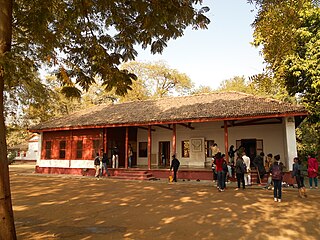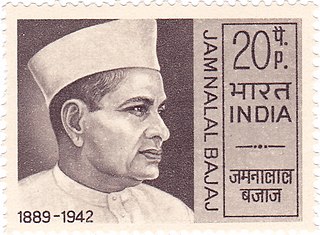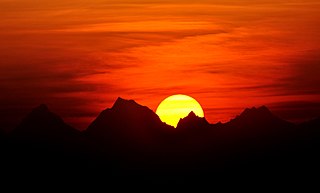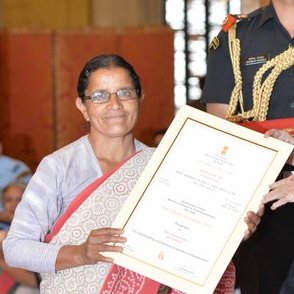
Sunderlal Bahuguna was an Indian environmentalist and Chipko movement leader. The idea of the Chipko movement was suggested by his wife Vimla Bahuguna and him. He fought for the preservation of forests in the Himalayas, first as a member of the Chipko movement in the 1970s, and later spearheaded the anti-Tehri Dam movement from the 1980s to early 2004. He was one of the early environmentalists of India, and later he and others associated with the Chipko movement and started taking up wider environmental issues, such as being opposed to large dams.

The Chipko movement is a forest conservation movement in India. Opposed to commercial logging and the government's policies on deforestation, protesters in the 1970s engaged in tree hugging, wrapping their arms around trees so that they could not be felled.

Sabarmati Ashram is located in the Sabarmati suburb of Ahmedabad, Gujarat, adjoining the Ashram Road, on the banks of the River Sabarmati, 4 miles (6.4 km) from the town hall. This was one of the many residences of Mahatma Gandhi who lived at Sabarmati (Gujarat) and Sevagram when he was not travelling across India or in prison. He lived in Sabarmati or Wardha for a total of twelve years with his wife Kasturba Gandhi and followers, including Vinoba Bhave. The Bhagavad Gita was recited here daily as part of the Ashram schedule.
Wardha is a city and a municipal council in Wardha district in the Indian state of Maharashtra. The administrative headquarter of Wardha district is situated here. Wardha gets its name from the Wardha River which flows on the northern, western and southern boundaries of the district. Founded in 1866, the town is now an important centre for cotton trade. Wardha was an important part of the Gandhian era.

Madeleine Slade, also known as Mirabehn or Meera Behn, was a British supporter of the Indian Independence Movement who in the 1920s left her home in England to live and work with Mahatma Gandhi. She devoted her life to human development and the advancement of Gandhi's principles.

Jamnalal Kaniram Bajaj was an Indian businessman and politician. He founded the Bajaj Group of companies in the 1920s, and the group now has 24 companies, including six that are listed on the bourses. He was also a close and beloved associate of Mahatma Gandhi, who is known to have often declared that Jamnalal was his fifth son.
Saraswathi Gora was an Indian social activist who served as leader of the Atheist Centre for many years, campaigning against untouchability and the caste system.

Kausani is a hill station and Village situated in Bageshwar district in the state of Uttarakhand, India. It is known for its scenery and its 300 km-wide panoramic view of Himalayan peaks like Trisul, Nanda Devi and Panchchuli. Mahatma Gandhi called this place the 'Switzerland of India', due to similarity in landscapes.

Chandi Prasad Bhatt is an Indian environmentalist and social activist, who founded Dasholi Gram Swarajya Sangh (DGSS) in Gopeshwar in 1964, which later became a mother-organization to the Chipko Movement, in which he was one of the pioneers. For his work Bhatt was awarded the Ramon Magsaysay Award in 1982, followed by the Padma Bhushan in 2005.

Shekhar Pathak is a historian, editor, publisher, activist, and traveller from Uttarakhand, India. He is known for his extensive knowledge of the history of colonial and postcolonial social movements and contemporary environmental and social issues in Uttarakhand, and colonial exploration in the Himalayas and Tibet. He has also been engaged in activism for various social and environmental causes since the 1970s.

The Garhwali people are an Indian ethnolinguistic group native to the Garhwal, in the Indian state of Uttarakhand, who speak Garhwali, an Indo-Aryan language.

Ramadevi Choudhury, also known as Rama Devi, was an Indian freedom fighter and a social reformer. She was called Maa (Mother) by the people of Odisha. The Ramadevi Women's University in Bhubaneswar has been named after her.

Anupam Mishra was an Indian Gandhian, author, journalist, environmentalist, TED speaker, and water conservationist who worked on promoting water conservation, water management and traditional rainwater harvesting techniques. He had been awarded the 1996 Indira Gandhi Paryavaran Puraskar (IGPP) award instituted by the Ministry of Environment and Forests, Government of India. He travelled to villages across several Indian states, especially Rajasthan, Madhya Pradesh, Maharashtra, and Uttar Pradesh, describing the value of time-tested systems of water harvesting. He advocated conservation of traditional water structures in India as well as abroad. He wrote books like Aaj Bhi Khare Hain Talaab and Rajasthan Ki Rajat Boondein, landmark works in the field of water conservation. An extensive interview with Mishra about the history and future of the Yamuna River occupies the last chapter of Rana Dasgupta's book Capital: The Eruption of Delhi.
Swami Anand was a monk, a Gandhian activist and a Gujarati writer from India. He was the manager of Gandhi's publications such as Navajivan and Young India and inspired Gandhi to write his autobiography, The Story of My Experiments with Truth. He wrote sketches, memoir, biographies, philosophy, travelogues and translated some works.
Thakurdas Bang was an Indian Gandhian philosopher and Gandhian economist. He was involved in the Indian independence movement. He practised Gandhism, Gandhian philosophy, Gandhian study even at the age of 95. He was also involved in Khadi and Sarvodaya movements. As an economic professor in G S College of Commerce he motivated many students like Madhukarrao Chaudhari, Justice Chandrashekhar Shankar Dharmadhikari and Ramakrushna Bajaj to participate in the freedom struggle. He is succeeded by Abhay Bang and Ashok Bang. Ashok Bang decided to work for issues related to farming and Abhay decided to work for health of villagers. Abhay and Rani Bang founded SEARCH - a non-profit organization in Gadchiroli, which is involved in rural health service and research
Jharna Dhara Chowdhury was a Bangladeshi social activist.
Amalprava Das, also known as Amal Prabha Das, (1911–1994) was an Indian social worker, Gandhian and the founder of Kasturba Ashram at Sarania Hills, Assam, a self help group for women and their economic upliftment and Guwahati Yubak Sevadal, a non governmental organization working for the social development of harijans. The Government of India honoured her in 1954, with the award of Padma Shri, the fourth highest Indian civilian award for her contributions to the society, placing her among the first recipients of the award. A recipient of the 1981 Jamnalal Bajaj Award, Das was honoured again by the Government of India with the second highest civilian award of Padma Vibhushan which she declined to accept.

Kamla Pant, born, Chamoli (Uttarakhand), is a feminist, politician and women's rights activist. She is also known for her work in the Uttarakhand movement, which resulted in Uttarakhand becoming a separate Indian state in 2000.
The Coolie-Begar or Coolie- Utar movement was a non-violent movement by the general public of Kumaun in the Bageshwar town of United Provinces in 1921. This movement was led by Hargovind Pant and Badri Datt Pandey, who were awarded the titles of 'Jannayak' and 'Kumaon Kesari' respectively after the success of this movement. The aim of this movement was to put pressure on the British to end the practice of Coolie-Begar. Mahatma Gandhi, while praising the movement, named it 'Bloodless Revolution'.

Basanti Devi is an Indian environmentalist. She has been concerned with preserving trees in Uttarakhand. She was awarded the highest award for women in India, the Nari Shakti Puraskar in 2016.














